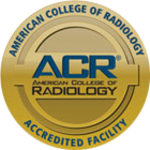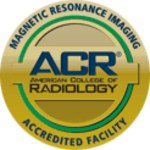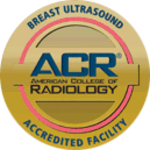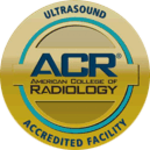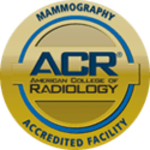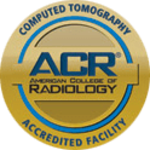Musculoskeletal MRI Quick Reference Guide for Physicians
Because MRI can give such clear pictures of soft tissue structures near and around bones, it is usually the best choice for examination of the body's major joints. MRI is widely used to diagnose sports-related injuries, injuries related to trauma as well as degenerative changes in the joints. Using MRI images, we can locate and identify the cause of pain, swelling or bleeding in the tissues in and around the joints and bones. The images allow us to clearly see even very small tears and injuries to tendons, ligaments and muscles and even some fractures that cannot be seen on x-rays. In addition, MRI images can give us a clear picture of degenerative disorders such as arthritis and deterioration of joint surfaces. MRI is also useful for the diagnosis and characterization of infections and tumors involving bones and joints.
Some of the more common musculoskeletal applications are listed below.
Routine MRI exams of the joints are done without contrast. If an infection or tumor is suspected, the study should be ordered without and with contrast. Please see the MRI Arthrography Physician Quick Reference Guide for further details regarding this topic.
Knee MRI
MRI of the knee is a very common and useful examination. It is the imaging test of choice in diagnosing and characterized tears of the meniscus. In addition, MRI can diagnose tears of the cruciate and collateral ligaments and surrounding tendons. MRI is very sensitive to diagnosis fluid within the knee as well.
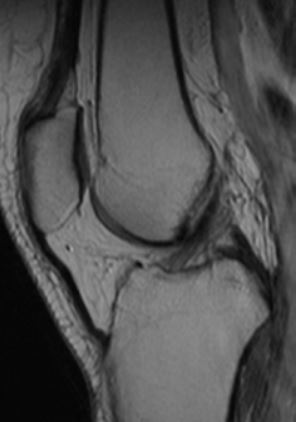
Knee MRI performed by Guilford Radiology, 2010
Ankle MRI
MRI of the ankle is a useful study in evaluating the tendons of the ankle. MRI is also useful in evaluating for plantar fasciitis, ligament tears, arthritis, fractures and other causes of ankle pain such as sinus tarsi syndrome, nerve entrapments and osteochondral lesions.
Hip MRI
MRI of the pelvis and hip is very useful in determining the source of either acute or chronic pain in the pelvis. The common causes of pain in the hip and pelvis includes: fractures, muscles strains, muscle tears, bursitis, arthritis and AVN.
Bone and Soft Tissue
MRI is an excellent test to evaluate the bones and soft tissues of the extremeties. X-rays are usually initially obtained. The MRI can be used to further evaluate findings on x-rays (or a CAT scan or bone scans), or can be used to further evaluate the cause of the patient’s symptoms when the x-ray exam is negative. MRI is excellent to evaluate the soft tissues as well.
CPT Codes:
MRI Lower Joints
- 73721 without contrast
- 73722 with contrast
- 73723 with and without contrast
MRI Upper Joints
- 73221 without contrast
- 73222 with contrast
- 73223 with and without contrast
MRI Lower Non-Joints
- 73718 without contrast
- 73719 with contrast
- 73720 with and without contrast
MRI Upper Non-Joints
- 73218 without contrast
- 73219 with contrast
- 73220 with and without contrast
Patient Preparation
For the MRI exam, if your patient is claustrophobic or anxiety is a problem, you may wish to prescribe a mild sedative to be given prior to the study. No other pre-visit preparation is necessary. Patients will need to remove all jewelry, hairclips, pony-tails and bobby pins. In addition, the patient will need to remove all clothing containing metal. This would include bras with metal enclosures and jeans with metal zippers and buttons. Your patient will be provided a gown and a secure locker in which valuables can be placed.
Patient Weight Limit
Our MRI equipment has a weight limit of 440 pounds.
Ready to Order a Test for your Patient?
General Information
MR imaging uses a powerful magnetic field, radio frequency pulses and a computer to produce detailed pictures of organs, soft tissues, bone and virtually all other internal body structures. MRI does not use ionizing radiation (x-rays). Detailed MR images allow physicians to better evaluate various parts of the body and determine the presence of certain diseases that may not be assessed adequately with other imaging methods.
Contraindications
Patients with cardiac pacemakers, ICD, or neuro-stimulators CAN NOT have an MRI. Patients with pins, plates, screws and joint replacements, stents & filters can have an MRI as long as it has been 6 weeks since placement of the device. Women who are pregnant should avoid having an elective MRI. Women who are pregnant and need an MRI should be individually evaluated for risk vs. benefits and should avoid an MRI in the 1st trimester of pregnancy.
How Does Your Patient Prepare?
A current creatinine (within 45 days) is needed on all patients over the age of 60, as well as patients that have high blood pressure, diabetes, acute vascular disease, or a history of kidney disease. Please fax these results with the order. Patients will need to remove all jewelry, hairclips, pony-tails and bobby pins. In addition, the patient will need to remove all clothing containing metal. This would include bras with metal enclosures and jeans with metal zippers and buttons. Your patient will be provided a gown and a secure locker in which valuables can be placed.
Risks
Although the strong magnetic field is not harmful in itself, implanted medical devices that contain metal may malfunction or cause problems during an MRI exam.
There is a very slight risk of an allergic reaction if contrast material is injected. Such reactions usually are mild and easily controlled by medication. If you experience allergic symptoms, a radiologist or other physician will be available for immediate assistance.
Nephrogenic systemic fibrosis is currently a recognized, but rare, complication of MRI believed to be caused by the injection of high doses of MRI contrast material in patients with very poor kidney function.
What Happens During the Test?
You will be asked to lie down on his back on the scanning table. The table will then slide into the scanning area. During the test, the MRI will make a rapid tapping noise. Some MRI examinations may require an injection of contrast material into a vein in the arm. Your experience and comfort are of key importance. Therefore, you can watch TV, be offered earplugs or a music headset; in addition blankets are also available. You should relax and remain still during the exam. Plan 60-90 minutes of total clinic time. The scan time can vary from 30-60 minutes depending on the study. You may resume normal activities following the MRI.
The Results
A radiologist will analyze the images and send a signed report to the referring physician within 1 business day.




